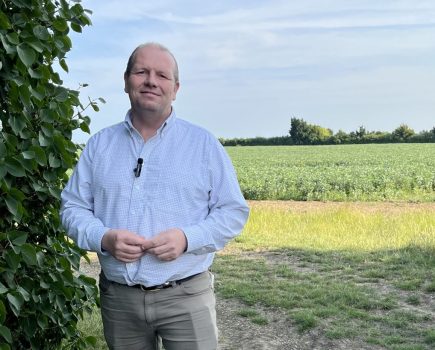By Martin Lines
It’s been the sunniest, warmest and driest first half of the year on record, and like many around my way in Cambridgeshire, we’ve harvested our crops around 2-3 weeks earlier than in a ‘normal’ year (whatever ‘normal’ means nowadays…).
Crops love sunshine and where moisture has been available, they look promising. But, any crops growing in fields with poor soil health or structure, or on lighter land, are struggling with the extreme lack of rain. On our farm, we’d had well over double the amount of rain by this time last year.
Taking the east coast train up to Edinburgh recently, I looked out the window at the huge variation in crop condition as the fields whizzed by. Fields that in the winter were scattered with puddles now contain crops in desperate need of moisture. It’s amazing how adjacent fields planted around the same time and with the same crop can look so different.
Soil health is crucial for resilience in light of our changing weather patterns. Those of us who are investing in returning organic matter to the soil, keeping it covered and with living roots for as long as possible, are seeing some benefits during this time of drought.
Thinking back, not only was there standing water in these fields last winter, but I noticed very little water in the ditches surrounding them – something definitely isn’t working. Whether that’s broken drainage or compacted soil, the water isn’t penetrating the ground meaning that in times of need there’s very little moisture available for the roots to access. If you spade a six-inch hole into the ground, is there any moisture in the soil at the bottom?
Our soil is hot, the air is hot, and this year is one of the windiest I can remember. Finding suitable spraying days has been a challenge so I’m all the more thankful for the beneficial insects that help to keep pests down in the meantime. The wind has also accelerated moisture evaporation from our soils and crops; I’m thankful for my hedgerows acting as a windbreak, slowing the flow of air (and therefore moisture) while providing habitat and forage for pollinators, predatory insects, and birds.
Water management is now critical to our future. We all have to start holding more water in the landscape in times of excess for use in times of drought, which will become increasingly frequent. We don’t want standing water in fields, but rather to slow the flow in our ditches, dykes, and where possible, allow it to soak through the soil to the required depth.
For some, this might mean storing excess rain in new areas of the farm either by constructing reservoirs or facilitating the flooding of areas that are increasingly being flooded in extreme rain. There’ll be little opportunity for mole draining this season, but with the fields starting to crack, the structure may be improved a little for free.
Ideally, we’d find a balance between keeping our ditches flowing to avoid soil saturation, and allowing more vegetation to develop. This both slows the flow of water away from the farm and cleans the water from sediment and nutrients that’d otherwise leave our fields. If we ensure the water leaving the farm is as clean as possible, we benefit our own land while improving the condition of our watercourses.
Water quality is a major focus for this government and they’ve already been pushing hard on water companies to reduce river pollution. Attention is starting to focus on agriculture, whether that’s excess nitrates in our rivers – and therefore drinking-water reservoirs – or phosphate and soil sediment leaving our fields, which deteriorates the quality of water.
Getting nutrient management plans right, ensuring the soil functions well, and avoiding nutrients leaving the farm will reduce our costs and prevent fines from the Environment Agency. I know of many farmers tackling this issue in creative, low-cost ways – from allowing reed beds to flourish to planting comfrey swales to filter the water of nitrogen, phosphorus, and potassium. Nature can do a lot of work for us if we let it.
During the past few years we’ve implemented a programme to clean out old ponds or create new ones in low-lying corners of fields. It not only provides wildlife with a consistent water source throughout the year, but is also an excellent insurance policy for any future fires on our farm, as the fire brigade can access most ponds to drop a pump into if required.
In times like these where my crops have been at the mercy of the blazing sun for months on end, I’m especially grateful for the bushy hedgerows, scruffy ponds, mature trees and healthy soil I’ve nurtured during the past years. No, my farm isn’t as neat and tidy as some, but without them, I might not have had a crop to harvest this year at all.
This article was taken from the latest issue of CPM. Read the article in full here.
For more articles like this, subscribe here.
Sign up for Crop Production Magazine’s FREE e-newsletter here.




